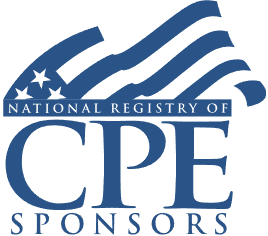Recognizing S Corporation Issues: Key Organizational Document Provisions, Ineligible Shareholders, Missed S Elections

Welcome! Strafford is now BARBRI! The expert courses you know from the trusted global leader in legal education.
Course Details
- smart_display Format
On-Demand
- signal_cellular_alt Difficulty Level
Intermediate
- work Practice Area
Tax Preparer
- event Date
Tuesday, January 28, 2025
- schedule Time
1:00 p.m. ET./10:00 a.m. PT
- timer Program Length
110 minutes
-
BARBRI is a NASBA CPE sponsor and this 110-minute webinar is accredited for 2.0 CPE credits.
-
BARBRI is an IRS-approved continuing education provider offering certified courses for Enrolled Agents (EA) and Tax Return Preparers (RTRP).
This webinar will identify commonly encountered issues with S corporation status and its shareholders. Our panel of flow-through entity experts will examine problems that frequently arise with these corporations and offer advice on preventing and correcting missteps.
Faculty

Ms. Hill specializes in tax planning and compliance for private businesses and their owners. She coordinates with estate planning attorneys, financial managers, transaction attorneys, family office managers, and bookkeepers to deliver comprehensive tax services.

Mr. Slipman is an attorney in Obermayer’s Business & Finance Department. He focuses his practice on tax structuring and analysis attendant to corporate transactions as well as advising clients on tax considerations critical to intercompany restructuring, debt financing, choice of entity questions, third-party financing, and formation and liquidation transactions. Mr. Slipman provides corporate tax and legal entity structuring guidance to clients in connection with complex commercial transactions, which have included significant IPOs. He believes in a practical deal-oriented approach to tax analysis with the goal of helping clients minimize tax exposures.
Description
Although there are many benefits of choosing a partnership or LLC entity structure for a business, S corporation filings continue to significantly surpass filings of partnership returns. This often chosen structure has many caveats that businesses and tax advisers should consider to avoid jeopardizing shareholders and their flow-through tax status.
The operating agreement should contain provisions for identical distribution and liquidation rights in order to prevent disproportionate distributions and a second class of stock. The IRS recently issued Revenue Procedure 2022-19 stating that disproportionate distributions will not violate the one class of stock requirement as long as appropriate language is in the operating agreement.
Even initially, shareholders may fail to make or adequately make the election for S corporation status. Specific errors and late elections can be remedied without a private letter ruling under Revenue Procedures 2013-30 and 2023-1. The initial shareholder list could exceed 100, the maximum number, or include ineligible foreign shareholders. Tax practitioners working with S corporations must be wary of the ramifications of S corporation status and its pitfalls.
Listen as our panel of S corporation advisers reviews common issues with Subchapter S corporations and offers advice to avoid and rectify oversights.
Outline
- Common S corporation issues: introduction
- Faulty organization documents
- Ineligible shareholders
- Corporation election issues
- Late elections
- Potential gain recognition
- Disproportionate distributions
- QSST and ESBT election failures
- Other issues
Benefits
The panel will review these and other critical issues:
- Key provisions that should be in S corporations' organizational documents
- Criteria for S corporation shareholders
- Remedying missed or late S corporation elections
- Avoiding QSST and ESBT election failures
NASBA Details
Learning Objectives
After completing this course, you will be able to:
- Identify key provisions that should be in organizational documents for S corporations
- Determine how disproportionate distributions impact Subchapter S status
- Decide criteria for S corporation shareholders
- Ascertain steps to take when a corporation fails to elect Subchapter S status
- Field of Study: Taxes
- Level of Knowledge: Intermediate
- Advance Preparation: None
- Teaching Method: Seminar/Lecture
- Delivery Method: Group-Internet (via computer)
- Attendance Monitoring Method: Attendance is monitored electronically via a participant's PIN and through a series of attendance verification prompts displayed throughout the program
- Prerequisite: Three years+ business or public firm experience preparing complex tax forms and schedules, supervising other preparers or accountants. Specific knowledge and understanding of pass-through taxation, including taxation of partnerships, S corporations and their respective partners and shareholders.

Strafford Publications, Inc. is registered with the National Association of State Boards of Accountancy (NASBA) as a sponsor of continuing professional education on the National Registry of CPE Sponsors. State boards of Accountancy have final authority on the acceptance of individual courses for CPE Credits. Complaints regarding registered sponsons may be submitted to NASBA through its website: www.nasbaregistry.org.

Strafford is an IRS-approved continuing education provider offering certified courses for Enrolled Agents (EA) and Tax Return Preparers (RTRP).
Unlimited access to premium CLE courses:
- Annual access
- Available live and on-demand
- Best for attorneys and legal professionals
Unlimited access to premium CPE courses.:
- Annual access
- Available live and on-demand
- Best for CPAs and tax professionals
Unlimited access to premium CLE, CPE, Professional Skills and Practice-Ready courses.:
- Annual access
- Available live and on-demand
- Best for legal, accounting, and tax professionals
Unlimited access to Professional Skills and Practice-Ready courses:
- Annual access
- Available on-demand
- Best for new attorneys
Related Courses

Special Needs Trusts: First-Party and Third-Party Reporting; Distribution Requirements
Thursday, September 18, 2025
1:00 p.m. ET./10:00 a.m. PT

Form 6198 At-Risk Limitations: IRC 465 Calculations, Grouping, Elections, and Schedules
Friday, September 26, 2025
1:00 p.m. ET./10:00 a.m. PT
Recommended Resources
How CPE Can Bridge the Gap Between What You Know and What You Need to Know
- Career Advancement